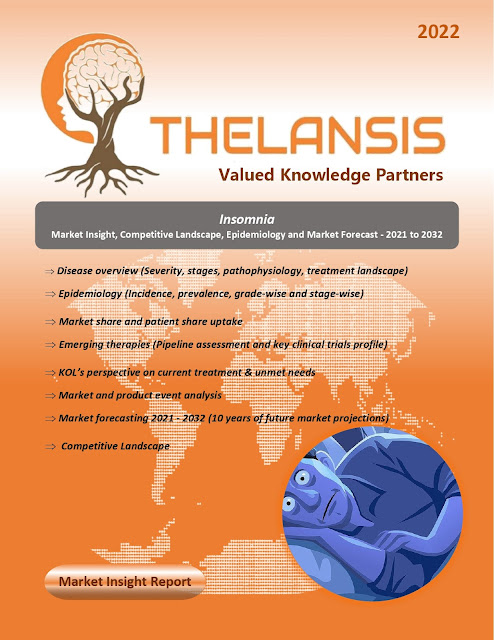Insomnia – Market outlook, Epidemiology, Competitive Landscape, and Market Forecast Report – 2021 To 2032
Insomnia is the most common clinical condition in which the person experiences difficulty sleeping and is subclassified as short-term, chronic, and other. Sometimes it is described as the presence of polysomnographic evidence of disturbed sleep. Therefore insomnia is considered to exist when there is long sleep latency, frequent nocturnal awakening, prolonged wakefulness throughout the sleep phase, or transient arousals. Insomnia can be a primary sleep disorder, comorbid sleep condition, and other mental or medical disorders. The etiology includes environmental, genetic, behavioral, and physiological factors culminating in hyperarousal. Insomnia is the complex interaction between cognitive arousal, altered circulation, and the homeostatic system. Decreased function of the sleep-walk switch may also contribute to insomnia. During sleep, there is a gradual shift from non-rapid-eye movement (non-REM) sleep to rapid-eye-movement (REM) sleep. The most common symptom was trouble sustaining sleep(61%), followed by early morning awakening(2.2%), difficulties beginning sleep(7.7%), and nonrestorative sleep (7.7%). The American Academy of Sleep Medicine divides rest into five stages: Stage W (wakefulness), Stage N1 (relaxed wakefulness), Stage N2 (light sleep), Stage N3 (deep or slow-wave sleep), and Stage R (REM sleep or dreaming). N1-N3 are non-REM sleep stages with minimal cortical activity, whereas REM sleep has significant cortical activity.
In the U.S., approximately 30% to 40% of
adults have insomnia. Short-term insomnia has an estimated prevalence of 9.5%,
and 1 in 5 cases of short-term insomnia progresses to chronic insomnia. People
with poor health or impaired quality of life are more likely to suffer from
insomnia (QOL).
The competitive
landscape of Insomnia includes country-specific approved and pipeline
therapies. Any asset/product-specific designation, review, and Accelerated
Approval are tracked and supplemented with analyst commentary.
KOLs insights of Insomnia
across 8 MM market from the center of Excellence/ Public/ Private hospitals
participated in the study. Insights around current treatment landscape,
epidemiology, clinical characteristics, future treatment paradigm, and Unmet
needs.
Insomnia
Market Forecast:
Patient Based Forecast Model (MS. Excel Based Automated Dashboard), which Data
Inputs with sourcing, Market Event, Product Event, Country specific Forecast
Model, Market uptake, and patient share uptake, Attribute Analysis, Analog
Analysis, Disease burden, and pricing scenario, Summary, and Insights.
S. No Asset Company Stage
1 Zolpidem Biolab
Sanus Farmaceutica Phase 3
2 CBT-I plus Melatonin Ache
Laboratorios Farmaceuticos S.A. Phase
3
3 Lemborexant Eisai
Inc. Phase 3
4 SM-1 Sequential
Medicine Ltd Phase 3
5 Daridorexant Idorsia
Pharmaceuticals Ltd. Phase 2
6 Neu-P11 Neurim
Pharmaceuticals Ltd. Phase 2
7 Tasimelteon Vanda
Pharmaceuticals Phase 3
8 Esmirtazapine Merck
Sharp & Dohme LLC Phase 3
9 MMFS-205-SR Neurocentria,
Inc. Phase 2
10 Cannabidiol Defined
Research Phase 2
Continued




Comments
Post a Comment